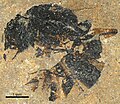Pachycondyla is a ponerine genus of ants found in the Neotropics. Pachycondyla is currently distributed from southern United States to northern Argentina...
5 KB (367 words) - 17:47, 14 October 2023
Pachycondyla minuta can refer to: Pachycondyla minuta MacKay & MacKay, 2010, synonym of Rasopone minuta Pachycondyla minuta Dlussky & Wedmann, 2012, homonym...
294 bytes (58 words) - 16:08, 6 November 2021
Megaponera (redirect from Pachycondyla analis)
genus under Pachycondyla even though he lacked phylogenetic justification, thereby changing the name from Megaponera foetens to Pachycondyla analis. In...
25 KB (2,657 words) - 13:40, 10 July 2024
stridulations Pachycondyla apicalis Stridulations from a Pachycondyla apicalis worker. Pachycondyla verenae Stridulations from a Pachycondyla verenae worker...
12 KB (1,317 words) - 06:49, 5 August 2024
Pachycondyla succinea is an extinct species of ant in the formicid subfamily Ponerinae described from fossils found in Europe. P. petrosa is one of three...
11 KB (1,213 words) - 00:33, 29 September 2024
Pachycondyla? messeliana is an extinct species of ants in the formicid subfamily Ponerinae described by from a fossil found in Europe. P.? messeliana is...
5 KB (596 words) - 23:11, 29 July 2023
Pachycondyla lutzi is an extinct species of ant in the formicid subfamily Ponerinae described by from fossils found in Europe. P. lutzi is one of six Lutetian...
5 KB (544 words) - 23:11, 29 July 2023
Pachycondyla aberrans is an extinct species of formicid in the ant subfamily Ponerinae known from a single fossil found in Russia. P. aberrans is known...
4 KB (409 words) - 18:37, 28 September 2024
Paltothyreus (redirect from Pachycondyla tarsata)
Paltothyreus (also known as African stink ant) is a monotypic genus of ants in the subfamily Ponerinae. Paltothyreus tarsatus, the single described species...
3 KB (276 words) - 02:32, 18 October 2023
Pachycondyla eocenica is an extinct species of ant in the formicid subfamily Ponerinae described from fossils found in Europe. P. eocenica is one of six...
5 KB (519 words) - 23:11, 29 July 2023
Dlussky & Wedmann, 2012 Pachycondyla eocenica Dlussky & Wedmann, 2012 Pachycondyla lutzi Dlussky & Wedmann, 2012 Pachycondyla? messeliana Dlussky & Wedmann...
27 KB (2,971 words) - 17:08, 4 November 2024
Pachycondyla parvula is an extinct species of ant in the formicid subfamily Ponerinae described by from a fossil found in Europe. P. parvula is one of...
5 KB (569 words) - 23:11, 29 July 2023
Pachycondyla harpax, the rapacious panther ant, is a species of ant in the family Formicidae. "Pachycondyla harpax Report". Integrated Taxonomic Information...
2 KB (80 words) - 01:48, 14 February 2024
Austroponera castaneicolor (redirect from Pachycondyla castaneicolor)
Taxon identifiers Pachycondyla castaneicolor Wikidata: Q610990 Wikispecies: Austroponera castaneicolor BOLD: 324189 CoL: 4BQTQ EoL: 485596 GBIF: 1319929...
2 KB (191 words) - 17:35, 20 October 2024
Brachyponera chinensis (redirect from Pachycondyla chinensis)
A. Zungoli & Eric P. Benson (2006). "Emergence of the introduced ant Pachycondyla chinensis (Formicidae: Ponerinae) as a public health threat in the southeastern...
4 KB (378 words) - 15:23, 19 March 2024
Pachycondyla petrosa is an extinct species of ant in the formicid subfamily Ponerinae described from a fossil found in Europe. P. petrosa is one of six...
5 KB (510 words) - 06:36, 24 February 2024
Pachycondyla petiolosa is an extinct species of ant in the formicid subfamily Ponerinae described by from a fossil found in Europe. P. parvula is one of...
5 KB (543 words) - 23:11, 29 July 2023
ants, bees, and wasps respectively. Termite-hunting ants of the genus Pachycondyla, also known as Matabele ants, form raiding parties consisting of ants...
32 KB (4,173 words) - 13:43, 29 April 2024
Pachycondyla oligocenica is an extinct species of formicid in the ant subfamily Ponerinae known from a fossil found in eastern Asia. P. oligocenica is...
5 KB (520 words) - 18:38, 28 September 2024
Buniapone (redirect from Pachycondyla amblyops)
Ponera, Trapeziopelta (now Myopias), Belonopelta, Pachycondyla, Pseudoponera, Euponera and Pachycondyla. One subspecies, B. amblyops oculatior from Indonesia...
4 KB (355 words) - 01:48, 18 October 2023
Ypresiomyrma (redirect from Pachycondyla rebekkae)
Cover and Moreau also included a redescription of the Danish species Pachycondyla rebekkae under the new name combination Ypresiomyrma rebekkae. A fourth...
19 KB (2,315 words) - 02:49, 29 September 2024
scrobes. Pachycondyla is regarded as the sister taxa to Dinoponera. Dinoponera, in addition to their size, are distinguishable from Pachycondyla by the...
17 KB (1,931 words) - 15:16, 18 September 2024
Brachyponera luteipes (redirect from Pachycondyla luteipes)
Myanmar, Nicobar Islands, Sri Lanka, Thailand, Vietnam, China, Japan "Pachycondyla luteipes". AntWeb. Retrieved 19 January 2014. "Brachyponera luteipes"...
2 KB (77 words) - 02:35, 1 October 2023
Austroponera castanea (redirect from Pachycondyla castanea)
nzor.org.nz. Landcare Research New Zealand Ltd. Retrieved 2018-02-03. Antweb LandCare Media related to Pachycondyla castanea at Wikimedia Commons v t e...
1 KB (46 words) - 00:02, 1 September 2024
worker-laid eggs are found, they are eaten. In some species, such as Pachycondyla obscuricornis, workers may try to escape policing by shuffling their...
77 KB (9,437 words) - 02:18, 4 November 2024
Crematogaster, Cylindromyrmex, Leptogenys, Odontomachus, Ophthalmopone, Pachycondyla, Rhytidoponera, Solenopsis and Wasmannia, also prey on termites. Specialized...
186 KB (20,251 words) - 18:55, 27 October 2024
a few species of medical importance, such as Solenopsis (fire ants), Pachycondyla, Myrmecia (bulldog ants), and Paraponera (bullet ants). In the case of...
4 KB (371 words) - 10:50, 21 June 2024
multiple gamergates. Examples of monogynous queenless species include Pachycondyla krugeri, P. sublaevis, Diacamma australe, D. rugosum, Dinoponera quadriceps...
23 KB (2,201 words) - 22:55, 11 November 2024
indicum, Myrmicaria striata, Myrmicaria brunnea, Oligomyrmex wroughtonii, Pachycondyla sp1*, Paratrechina sp1*, Pheidole sharpi, Pheidole sp1*, Pheidole sp2*...
15 KB (1,204 words) - 20:40, 1 November 2024
repel them. The ant most frequently found in the vestibular cell was Pachycondyla astuta, an aggressive species with a potent sting. D. ossarium parasitism...
3 KB (272 words) - 07:02, 29 January 2024


























